The flame war between charcoal grill purists and gas grill hotheads burns brighter than the debate between Mac and PC users. You should read some of the slop slung on the barbecue message boards. On second thought, don't. Let me try to sort it out for you with a few inflammatory thoughts.
Grills are used mostly for three types of cooking:
1) High heat direct radiation cooking when the food is placed directly above the heat source for things like steaks.
2) Indirect heat convection roasting for things like whole chickens and roasts when the heat source is off to the side and the food cooks by warm air circulating around it.
3) Indirect heat smoke roasting for things like ribs when the warm air is heavy with flavorful hardwood smoke.
Let's see how each fuel performs at these tasks and all the other factors.
Is there a taste difference?
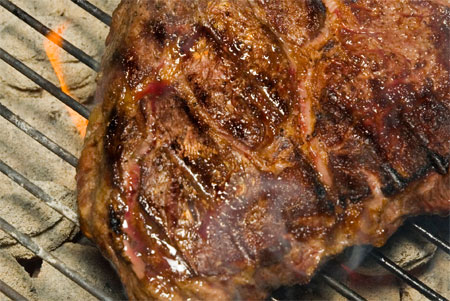 Charcoal makes a tiny bit more smoke than gas, although, when lit properly, good charcoal produces little smoke and it is not likely to get into food that is cooked quickly such as burgers, hot dogs, or even steaks.
Charcoal makes a tiny bit more smoke than gas, although, when lit properly, good charcoal produces little smoke and it is not likely to get into food that is cooked quickly such as burgers, hot dogs, or even steaks.
The smoke you see when grilling comes mostly from drippings from the food hitting the hot coals. Meat drippings are mostly water, fat, and protein plus whatever you have added, like sugar in barbecue sauce. When drippings hit the coals they vaporize and some of that condenses on the meat and some penetrates into the meat. Most gas grills cover the flame jets with metal plates, lava rock, or ceramic rocks that absorb the heat and radiate it. Drippings hit these radiant surfaces where it is vaporized, making smoke and steam, just like charcoal.
There is also a minor difference in the flavor imparted by combustion gasses, the volatile byproducts given off by the burning of the charcoal or the gas. When propane combusts it makes more steam than charcoal, and some say that keeps meat moist giving gas an advantage. Others think the steam is a disadvantage, hampering chicken skin from getting crisp.
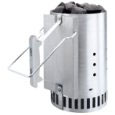 There is one other flavor difference of note. If you use self-igniting charcoal or charcoal fluid to start a charcoal fire, there can be an unpleasant petrochemical smell during ignition and it can get into the food. Yuk. For this reason you should use a charcoal chimney or an electric charcoal starter. I prefer the chimney because it is faster and easier and needs no outlet. My fave is the Weber Rapidfire Chimney Starter.
There is one other flavor difference of note. If you use self-igniting charcoal or charcoal fluid to start a charcoal fire, there can be an unpleasant petrochemical smell during ignition and it can get into the food. Yuk. For this reason you should use a charcoal chimney or an electric charcoal starter. I prefer the chimney because it is faster and easier and needs no outlet. My fave is the Weber Rapidfire Chimney Starter.
If you use your grill for smoke roasting, there is a more noticeable difference in flavor. The combustion gases from charcoal when mixed with smoke from wood chips or chunks makes a distinctive flavor typical of traditional southern barbecue. On a propane grill, the flavor is a bit more bacon-like. Which is better? Taste is a matter of taste.
But when it comes to direct heat grilling, the fact is that, if all things are equal such as cooking temp, most folks can't tell the difference in the taste between charcoal and gas grilled food. If you use strong flavored rubs, marinades, and sauces, you will never notice taste differences. You may think you can, but blind tastings have shown that you probably can't. So if there is little taste difference, the choice comes down to functionality.
Charcoal pros and cons
 Charcoal purists are vehement and border on snobbery. They who would never ever never own a gas grill. They claim it is the flavor, but for me, a lot of it is the thrill of playing with fire and the ritual.
Charcoal purists are vehement and border on snobbery. They who would never ever never own a gas grill. They claim it is the flavor, but for me, a lot of it is the thrill of playing with fire and the ritual.
The real reason to buy a charcoal grill is that charcoal can get hotter than standard gas grills, and heat is what you need to get steaks and lamb crisp on the outside and red or pink on the inside. Charcoal grills typically cook up to 500F. If you use a lot of coals or if the coals are raised close to the cooking surface, they can cook as hot as 700F. When I get my hands on top quality lamb or beef, I use bricks to raise the charcoal grate on my Weber Kettle to within 1" of the meat and the result looks and tastes as good as anything you can get at Morton's (see the picture at the top of this page). My favorite charcoal grills have a crank that let you raise and lower the charcoal bed.
On the down side: Charcoal is dirty to handle; it can be hard to light; it takes about 15 minutes longer to get up to temp; there can be flare-ups that can burn the food and that is a health risk; it is hard to tell what temp you are cooking at; the temperature cannot be turned down rapidly; during long cooks it slowly loses heat and you need to add more charcoal; charcoal grills rarely have rotisseries; and there is a lot of ash to clean up after.
Most of these problems are easily surmounted if you know how: If you use gloves, shovels, or tongs, you need not ever handle raw coals. If you keep the charcoal dry and use a chimney, getting hot coals is easy. If you push the coals to one side of the grill and set up a 2-zone cooking environment, fatty meats like chicken skin does not drip on the coals and flare up, and even if there are flareups, a squirt gun can contain them. And cleanup of ash is easier with some of the one-touch grills or grills that have removable ash trays.
2008 Grill & Smoker Shipments
58% Gas
40% Charcoal
2% Electric16,682,400 total
The most important part of any cooking, indoor or out, is regulating heat. To do that you need a reliable oven thermometer, and a little know how that takes time to acquire. Alas I have never seen a charcoal grill with a really good thermometer, and the thermometer is never mounted where it is needed, near the meat. The temp in the top of the dome can be very different at meat level.
Since charcoal grills do not have temperature dials to raise or lower temp, it is important to learn how to set up a 2-zone fire which helps you regulate heat by moving meat from the hot to the medium zone, and learn how to control the energy of the fire by closing off the oxygen intake vents. They are your temperature dials.
In short, cooking with charcoal can yield excellent results if you practice. The high heat is perfect for red meats, and if you learn your instrument, it will reward you handsomely. It is not intuitive and brainless, but there is little it cannot do when you achieve mastery, Grasshopper.
Gas pros and cons
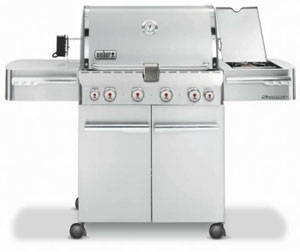 Gas grills outsell charcoal grills and it is easy to understand why. They offer convenience and control. Those two words alone could cinch the argument.
Gas grills outsell charcoal grills and it is easy to understand why. They offer convenience and control. Those two words alone could cinch the argument.
They are easy to start, heat up within 10-15 minutes, hold temperatures steadily, are easy to clean, and can be configured for indirect and multi-zone cooking. If it's Tuesday and you need dinner ready in an hour, the gasser can do it. Low to mid-price gas grills typically have a top end of 400-600F. More expensive grills can get up to 700F.
Alas, they are not perfect. A dial setting of 1 may equal 275F on a 70F day, but it can be 225F on a cool, windy, or rainy day. Or 300F on a hot day. But once you get to know your instrument, it is pretty easy to manage and if it has two or more burners it is easy to have two or more heat zones. On a three burner grill you might use a hot zone for meat, a medium zone for veggies, and a low zone for holding finished foods. It is still necessary to know what temperature you are cooking at, and the thermometers on most gas grills are not precise, so I strongly recommend you buy a good digital oven thermometer and a good digital meat thermometer.
Most gas grills use metal plates, lava rocks, and ceramics to radiate heat, so there are no open flames, no flareups, and cleanup is easier because drips are usually vaporized. There's little or no ash, so gassers are easier to clean, but they suffer from carbon and grease buildups that need to be scraped or pressure washed every few months. There are also gas jets and venturis that can clog up. I have even had to dig a wasp's nest out of one of the tubes once. Some people discard the lava rocks or ceramics every year. Others think that the buildup of grease in the porous materials produces desirable flavors. My brother-in-law makes the world's finest swordfish on a crappy old gas grill with lava rocks he has been using since they were harvested in the last ice age. Some of his lava rocks have begun to disintegrate and there are gaps where bare flame slips through to lick the meat. I have never been able to come close to his swordfish on all my fancy toys.
Gas grills can come with a wide range of accessories. Most are set up so you can easily attach a rotisserie accessory and many come with side burners so you can keep sauces warm or cook side dishes. You can get night lights, side tables, spice racks, storage drawers, side burners, and there' probably even one with a DVD player.
The biggest problem with gas grills is that only the top end models get hot enough to get a steak crunchy on the exterior without overcooking the interior. If you like your steaks well done, gas grills are perfect for you. But if you like your meat crunchy on the outside and rare to medium rare on the inside, the temp at which it is most tender and juicy, then most gas grills just don't get the job done. The italicized word is "most". Many of the more expensive gas grills now come with "infrared" burners off to one side. This is a bit of a misnomer because all grills cook by infrared, or heat, radiation. Infrared burners use a gas flame to superheat a ceramic or metal plate that radiates much more heat than standard burners. As much as twice the heat. In the 700F plus range. That's the kind of temps that steakhouses cook at. They can give you those deep dark crusty steaks with red or pink interiors. Alas, most infrared burners are only big enough for one or two steaks at a time.
Infrared burners may be perfect for steaks, but they are much too hot for direct heat cooking of most fish and veggies. Even with steaks, you need to keep an eye on food over direct infrared. They can incinerate in a hurry. Infrared burners can sometimes be used for rotisserie cooking and can even be used for indirect heat cooking.
Some high end gas grills also have smoke boxes for wood chips, but for most gas grills you need to make foil packets or put pans of wood down under the cooking grate near the flame. Even though it is not recommended, I often throw aromatic woods right down near the burners.
Alas, most gas grill lids do not seal well, so a lot of the smoke is lost and more wood is needed than on a tighter grill. Because the mechanisms are more complex, gas grills tend to be more expensive than comparable charcoal grills, assembly of new gas grills is more complex that charcoal grills, and there are more parts to break and be replaced.
Two types of gas
LP gas comes in 20 pound steel tanks. If you have an LP grill you should always have a full backup tank on hand. Nothing is more annoying than setting a chicken on the grill, cranking up the lawn mower, and returning in 30 minutes to discover that the tank ran out and the bird is raw.
Propane gas is ideal for grills because, when pressurized, it compresses and turns to liquid, making it easy to store in tanks. It also contains more cooking energy than natural gas as measured in British Thermal Units (BTU). A BTU is the amount of energy required to raise the temperature of one pound of water 1F. There are about 2,500 BTU in one cubic foot of propane and only about 1,000 BTU in one cubic foot of natural gas.
Gas grills typically range from 15,000 to 60,000 BTU per hour. Manufacturers tout the number of BTU their grills can produce, but the number can be misleading. The number of BTU is not indicative of the heat it can generate. That must be calculated by BTU per square inch, something they never tell you. Higher BTU grills usually have more cooking surface over which the BTUs are spread. Small grills can have as little as 5,000 BTU and large ones up to 60,000. Higher BTU grills use more fuel if you use all burners. 55-75 BTU/square inch is the typical range. Sideburners typically run 10,000-15,000 BTU.
Natural gas is mostly methane. It must be delivered to the grill by a pipeline from your house so a certified contractor will be needed to do the installation and the grill must be parked in a permanent location. Propane grills cannot be hooked up to natural gas without an adapter kit and the regulator may need to be adjusted. Natural gas is cheaper than LP gas and you never have to worry about running out, unless you don't pay your gas bills.
Other fuel choices
Wood. I frequently cook steaks in my Weber Kettle over grape vine and fruit wood cuttings. I dry stacks of the pencil thick sticks for a few months, and then stuff as many as I can into my grill. On goes the top grate. I light them from below and within 10 minutes I have 8' flames. They die down to white hot coals in about 10 minutes, and I have about 15 minutes of 1000F temps to cook on before they die. Nice flavor, too.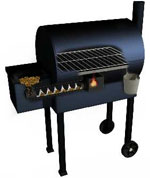
Wood Pellets. There are several nice grills that burn wood pellets made by compressing sawdust. They can get hot enough for direct heat grilling, but most owners tell me, while they are great for smoke roasting, they are not good grilling tools.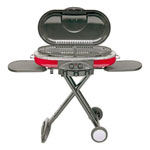
Electricity. There is a new breed of electric grills that are ideal for apartments with small balconies. Some models can get quite hot. There is a lot of grease to clean, but many of them are non-stick coated and some of the parts can go into the dish washer.
Which to buy?
 Which to buy? I have one of each. Almost all my birds, fish, veggies, pizzas, and breads go on my LP gas grill, almost all my red meats go on my charcoal grill. If you're starting out, and you want no fuss no muss, go gas. If you can afford it, get an infrared burner and a side burner.
Which to buy? I have one of each. Almost all my birds, fish, veggies, pizzas, and breads go on my LP gas grill, almost all my red meats go on my charcoal grill. If you're starting out, and you want no fuss no muss, go gas. If you can afford it, get an infrared burner and a side burner.
If you're willing to put in a bit more time to gain mastery of your tool, then go charcoal, and look for one that let's you raise and lower the coal.
Or you could buy the Char-Griller Duo (right), which does both. Not a great grill, but I'll bet we see more duos in the future.
I'm waiting for the trio. Charcoal, gas, and infrared!
More useful info
Either way, before you make a purchase, read my article on How to Buy a Grill or Brazier.
For killer ribs and real Southern barbecue, there's no substitute fot a dedicated standalone smoker. Read my article on How to Buy a Smoker
Cooking is a balance of time and temp. Every outdoor cook needs a good oven thermometer and meat thermometer. Read my article on How to buy a thermometer.
For more info about charcoal, read my article The Zen of Charcoal.
Copyright (c) 2009 By Craig "Meathead" Goldwyn, AmazingRibs.com, and all rights are reserved. Click here for information on reprint rights.
This story appears in the special Summer Issue of our weekly iPad magazine, Huffington, in the iTunes App store, available Friday, May 24.